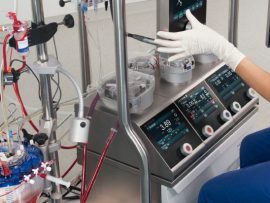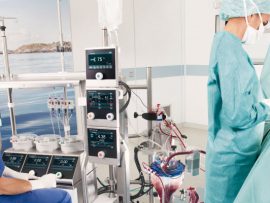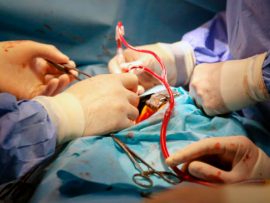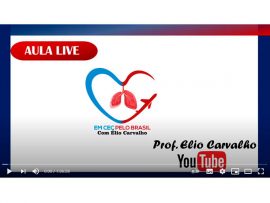Abstract Background. To decrease the complications associated with cardiopulmonary bypass, novel biomaterials have been introduced that may be less thrombogenic than standard synthetic surfaces. Methods. Thirty-four patients undergoing coronary..
Read MoreTake Home Points: modified Dixon (mDixon) 3D cardiovascular magnetic resonance angiography (CMRA) demonstrates reduced artefact burden and better delineation of head and neck vessels as well as pulmonary veins compared..
Read MoreDe battre le cœur a continué. Le 26 mars 2021, les équipes de chirurgie cardiaque et d’anesthésie-réanimation du CHU de Rennes ont réalisé une transplantation cardiaque d’un genre nouveau..
Read MoreAbstract We present a dissection of the patent ductus arteriosus and pulmonary artery for surgical repair utilising cardiopulmonary bypass in the setting of vein of Galen malformation. Several strategies were..
Read MoreAbstract The wet priming of extracorporeal membrane oxygenation systems and storage of these systems for rapid deployment is common practice in many clinical centers. This storage policy is, however, seen..
Read MoreAbstract Background The utilization of venoarterial extracorporeal membrane oxygenation (VA‐ECMO) as a life‐supporting therapy has increased exponentially over the last decade. As more patients receive and survive ECMO, there are..
Read MoreAbstract Postoperative neurologic complications have a significant effect on morbidity, mortality, and long-term disability in patients undergoing cardiac surgery. The etiology of brain injury in patients undergoing cardiac surgery is..
Read MoreThe authors present a case of mitral valve (MV) repair combined with pectus excavatum repair in a highly symptomatic 28-year-old woman. Her preoperative transesophageal (TEE) echo showed severe mitral insufficiency,..
Read MoreA 53-year-old man was admitted with a two-month history of anterior myocardial infarction, congestive heart failure, and a New York Heart Association III classification. Echocardiography showed severe mitral insufficiency (Carpentier..
Read MoreThe patient was a 6-year-old boy with no symptoms and a finding of a systolic heart murmur on the left sternal border on a routine examination. Echocardiogram showed left ventricular..
Read MoreThis video demonstrates a case report of a 33-year-old man diagnosed with Tetralogy of Fallot (ToF). He had progressive exertional dyspnea with oxygen saturation 91% and NYHA class II-III. The..
Read MoreWe are presenting the case of minimally invasive repair of large left ventricle inferior pseudoaneurysm and concomitant CABG procedure. The patient was a 63-year-old man who presented with shortness of..
Read MoreKeith Samolyk, CCP discusses the physiology of fluid management and the importance of maintaining Colloid Oncotic Pressure (COP).
Read MoreFluid, Volume, and Blood Management. A multidisciplinary approach to autologous blood.
Read MoreAbstract Both antiviral treatment with remdesivir and hemoadsorption using a CytoSorb® adsorption device are applied in the treatment of severe COVID‐19. The CytoSorb® adsorber consists of porous polymer beads that adsorb a..
Read MoreAbstract Background: Thromboembolism and bleeding contribute to Coronavirus disease 2019 (COVID-19)’s morbidity and mortality and are also frequent complications of venovenous extracorporeal membrane oxygenation (vvECMO). As the interaction of the..
Read MoreAbstract Background: Monitoring oxygen delivery to the oxygenator of a heart lung machine (HLM) is typically accomplished with an O2 analyzer connected to the gas inflow line. It is assumed when..
Read MoreAbstract Extracorporeal membrane oxygenation (ECMO) bridge to lung transplantation (LuTX) exposes the patients to a high risk of perioperative bleeding secondary to systemic anticoagulation and coagulation factors deficiency. With this..
Read MoreAbstract Background Early studies conclude patients with Covid-19 have a high risk of death, but no studies specifically explore cardiac surgery outcome. We investigate UK cardiac surgery outcomes during the..
Read MoreAbstract Objectives To evaluate recent practice and outcomes of reoperative cardiac surgery via re-sternotomy. Use of early versus late institution of cardiopulmonary bypass (CPB) before sternal re-entry was of particular..
Read MoreAbstract Objective Failure of membrane oxygenator (MO) function of venovenous extracorporeal membrane oxygenators (VV ECMO) remains problematic. The development of device-induced coagulation disorder (COD) or worsened gas transfer (WGT) necessitates..
Read MoreAbstract Objectives Kidney Disease: Improving Global Outcomes (KDIGO) guidelines include assessment of creatinine and urine output to identify acute kidney injury (AKI). Whether urine output is an accurate indicator of..
Read MoreAbstract Background Single- (SL) and double-lumen (DL) catheters are used in clinical practice for veno-venous extracorporeal membrane oxygenation (V-V ECMO) therapy. However, information is lacking regarding the effects of the..
Read MoreAbstract Background Early hypercapnia is common in patients with acute respiratory distress syndrome (ARDS) and is associated with increased mortality. Fluctuations of carbon dioxide have been associated with adverse neurological..
Read MoreAbstract OBJECTIVES: Monitoring cerebral autoregulation may help identify the lower limit of autoregulation in individual patients. Mean arterial blood pressure below lower limit of autoregulation appears to be a risk..
Read MoreAbstract Background Atrial flutter (AFL) is a supraventricular tachyarrhythmia. In the ECG tracing, it is marked by a fast, irregular atrial activity of 280–500 beats per minute. AFL is known..
Read MoreAbstract Type A aortic dissection most often requires emergent surgery to prevent malperfusion, stroke, and/or rupture of aorta. To achieve the structural goals of the operation, the conduct of the..
Read MoreAbstract Objective To determine the predictors of postoperative acute kidney injury (AKI) following nonemergent cardiac surgery among patients with variable preoperative estimated glomerular filtration rate (eGFR) levels. Methods A retrospective..
Read MoreThis case reports on a 24-year-old female patient who was admitted to the hospital in an unresponsive state with suspected overdose of clonazepam and quetiapine, presumably 1 hour post ingestion...
Read MoreAula sobre condução na CEC em pacientes adultos! Prof. Elio Carvalho é Biomédico, Microbiologista e Perfusionista pela Unicamp, CLAP e SBCEC. É perfusionista do Hospital de Clínicas da Unicamp e..
Read More

























